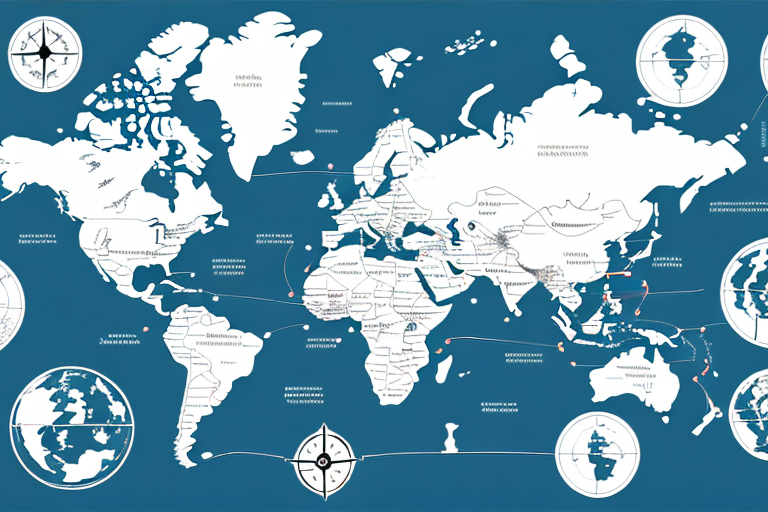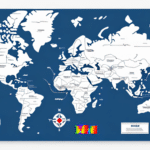Understanding UPS 178 Pound Shipping Rates
When it comes to shipping with UPS, one factor that could significantly impact your business's bottom line is the 178-pound weight threshold. In this article, we'll explore why 178-pound shipping rates matter to your business, how to calculate them, ways to negotiate better rates, and tips for reducing your shipping costs. Additionally, we'll discuss the impact of dimensional weight, how to navigate the complexities of UPS shipping zones, and the differences between UPS ground and air shipping rates. We'll also explore the benefits of working with a third-party logistics provider and the role of packaging in your UPS 178-pound shipping rate.
Why 178-Pound Shipping Rates Matter to Your Business
Shipping rates are determined by a variety of factors, including package weight and destination. However, the 178-pound weight threshold is particularly important because it represents a tipping point in UPS's pricing structure. For packages that weigh less than 178 pounds, the cost is calculated based on weight and destination. Once a package exceeds 178 pounds, additional fees, such as oversized package surcharges, are applied. According to UPS's [official rate guide](https://www.shipscience.com/ups-rate-guide), these additional fees can increase your shipping costs by up to 30%, making it crucial to stay within the 178-pound limit whenever possible.
Another reason why the 178-pound shipping rate matters to your business is that it affects the delivery time. Packages that weigh less than 178 pounds are typically shipped through UPS's standard ground service, which takes 1-5 business days depending on the destination. However, packages that exceed 178 pounds require special handling and may take longer to deliver. This delay can be problematic if you have time-sensitive shipments that need to arrive quickly.
Furthermore, exceeding the 178-pound weight limit can impact the safety of your package during transit. Heavier packages are more likely to be damaged or mishandled, resulting in costly returns or replacements. By adhering to the weight limit, you can ensure that your packages are handled with care and arrive safely at their destination.
The Impact of Dimensional Weight on UPS Shipping Rates
Dimensional weight is a pricing method that considers both the size and weight of a package to determine shipping costs. UPS uses this method to account for the space a package occupies on delivery vehicles. If a package's dimensional weight exceeds its actual weight, the shipping cost is calculated based on the dimensional weight. For example, a large but lightweight package may cost more to ship than a smaller, heavier one.
According to recent data from the [Freight Shipping Association](https://www.shipscience.com/freight-shipping-data), dimensional weight pricing has increased by 15% over the past year across major carriers, including UPS, FedEx, and DHL. To minimize these costs, consider the following strategies:
- Use smaller boxes that fit your products snugly.
- Eliminate excess packaging materials.
- Opt for flat-rate shipping boxes when applicable.
Reducing the dimensional weight of your packages not only lowers shipping costs but also contributes to a more sustainable shipping process by minimizing fuel consumption and emissions.
Navigating the Complexities of UPS Shipping Zones
UPS divides the country into shipping zones based on the distance from the package's origin. Each zone is assigned a numeric value, with higher numbers indicating greater distances. Shipping costs increase as packages cross more zones. To accurately calculate shipping costs, you need to determine the package's weight, destination zone, and any applicable surcharges.
For businesses operating in multiple regions, managing shipping zones can be complex. Utilizing UPS's [Zone Calculator](https://www.shipscience.com/ups-zone-calculator) can help streamline this process. Additionally, partnering with a third-party logistics provider can provide expert guidance on optimizing shipping routes and rates.
How to Calculate UPS 178-Pound Shipping Rates
Calculating UPS's 178-pound shipping rates involves several factors:
- Package Weight: Ensure your package does not exceed 178 pounds to avoid additional surcharges.
- Destination: Use the UPS Zone Calculator to determine the shipping zone of your destination.
- Shipping Option: Decide between ground, air, or international shipping based on your delivery timeline and budget.
- Additional Fees: Account for potential fees such as fuel surcharges, residential delivery fees, and oversized package surcharges.
UPS offers a suite of [online tools](https://www.shipscience.com/ups-shipping-tools) to assist in estimating shipping costs. By inputting your package details, you can receive an accurate cost projection and choose the most cost-effective shipping method.
Negotiating Better Shipping Rates with UPS
If your business ships large volumes with UPS, negotiating better rates can lead to significant savings. Here are some strategies:
- Understand Your Shipping Patterns: Analyze your shipping data to identify high-volume periods and common shipment types.
- Compare Carrier Rates: Research rates from other carriers to leverage competitive pricing during negotiations.
- Build Relationships: Establish strong relationships with your UPS account representative to facilitate better terms.
- Explore Contract Terms: Negotiate for bulk shipping discounts, waived fees, or customized service packages.
According to a study by the [Logistics Management Institute](https://www.shipscience.com/logistics-management), businesses that actively negotiate their shipping contracts can reduce their shipping costs by up to 20% annually.
Tips for Reducing Your Shipping Costs with UPS
Beyond negotiating rates, there are several strategies to minimize your overall shipping expenses:
- Optimize Packaging: Use appropriately sized boxes and high-quality packing materials to reduce dimensional weight and prevent damage.
- Consolidate Shipments: Combine multiple orders into a single shipment to take advantage of bulk shipping rates.
- Utilize UPS Services: Explore UPS's various shipping options, such as ground services or consolidated shipping programs, to find the most cost-effective solutions.
- Leverage Technology: Implement shipping software that integrates with UPS to automate rate calculations and streamline the shipping process.
Partnering with a third-party logistics provider (3PL) can also help identify additional cost-saving opportunities by analyzing your shipping operations and recommending improvements.
Understanding the Differences Between UPS Ground and Air Shipping Rates
When choosing between UPS ground and air shipping, consider the following differences:
- Cost: UPS ground shipping is generally more cost-effective, especially for heavier and non-urgent shipments.
- Speed: UPS air shipping offers faster delivery times, often within 1-3 business days, making it ideal for time-sensitive deliveries.
- Reliability: Air shipping typically provides more consistent delivery schedules, reducing the risk of delays.
- Environmental Impact: Ground shipping has a lower carbon footprint compared to air shipping.
For detailed comparisons, refer to UPS's [shipping options guide](https://www.shipscience.com/ups-shipping-options).
The Benefits of Working with a Third-Party Logistics Provider for UPS Shipments
Partnering with a third-party logistics provider (3PL) can offer numerous advantages for your shipping operations:
- Expertise: 3PLs have in-depth knowledge of shipping best practices and can navigate complex UPS rate structures.
- Cost Savings: They can negotiate better rates on your behalf and identify opportunities for reducing shipping expenses.
- Efficiency: Access to advanced technologies and platforms can streamline your shipping processes.
- Scalability: 3PLs can easily scale your shipping operations to accommodate business growth.
By leveraging the services of a 3PL, you can focus on core business activities while ensuring your shipping logistics are handled efficiently and cost-effectively.
Common Mistakes to Avoid When Estimating UPS Shipping Costs
Accurate estimation of UPS shipping costs is crucial to avoid unexpected expenses. Here are some common mistakes to avoid:
- Ignoring Dimensional Weight: Failing to consider dimensional weight can lead to higher shipping costs. Always calculate both actual and dimensional weights.
- Using Inaccurate Shipping Zone Information: Incorrectly determining the shipping zone can result in overpaying for shipping. Utilize UPS's [Zone Calculator](https://www.shipscience.com/ups-zone-calculator) for accurate information.
- Overlooking Additional Fees: Additional charges such as fuel surcharges, residential delivery fees, and oversized package fees can inflate your shipping costs. Ensure you account for all potential fees in your estimates.
- Poor Packaging: Using inappropriate packaging can increase your package's weight and dimensions, leading to higher costs and potential damage during transit.
By being aware of these pitfalls, you can make more informed decisions and optimize your shipping budget effectively.
How to Maximize Your Savings on Large Volume Shipments with UPS
For businesses that handle large volume shipments, maximizing savings with UPS involves strategic planning and execution:
- Negotiate Volume Discounts: Engage with UPS representatives to secure discounts based on your shipping volume.
- Implement Shipping Automation: Utilize shipping software to automate label creation and rate calculations, reducing manual errors and saving time.
- Optimize Shipping Routes: Analyze your shipping data to identify the most efficient routes and reduce transit times.
- Partner with a 3PL: A third-party logistics provider can offer expertise and resources to streamline your shipping operations and identify further savings.
According to industry reports from the [Supply Chain Management Review](https://www.shipscience.com/supply-chain-reports), businesses that implement these strategies can achieve up to a 25% reduction in shipping costs.
The Role of Packaging in Your UPS 178-Pound Shipping Rate
The packaging you use plays a critical role in determining your UPS shipping rates, especially around the 178-pound threshold:
- Size and Weight: Oversized or heavy packaging can push your package over the 178-pound limit or increase its dimensional weight, leading to higher shipping costs.
- Material Quality: Using sturdy, high-quality packaging materials can protect your products during transit, reducing the risk of damage and associated costs.
- Efficiency: Optimizing your packaging to use the smallest possible size without compromising product safety can lower both actual and dimensional weights.
UPS provides guidelines on [proper packaging](https://www.shipscience.com/ups-packaging-guidelines) to help businesses adhere to weight and size restrictions while ensuring their packages arrive safely.
Case Study: How One Company Saved Thousands on Their UPS Shipping Costs
XYZ Corporation is a prime example of a company that successfully reduced its UPS shipping costs. By partnering with a third-party logistics provider (3PL), XYZ Corporation was able to:
- Optimize their packaging to reduce dimensional weight and adhere to the 178-pound limit.
- Negotiate better rates with UPS based on their high shipping volumes.
- Implement shipping automation tools to streamline their logistics operations.
As a result, XYZ Corporation saved over $50,000 annually in shipping costs. These savings were reinvested into other areas of the business, enhancing overall efficiency and profitability.
The Future of UPS Shipping Rates and What It Means for Your Business
The shipping industry is continually evolving, influenced by technological advancements and changing consumer demands. Key trends to watch include:
- Rise of E-Commerce: The increasing demand for fast and affordable shipping options is pushing carriers like UPS to innovate their pricing structures and delivery methods.
- Sustainability Initiatives: There is a growing emphasis on eco-friendly shipping practices. UPS is investing in electric delivery vehicles and sustainable packaging solutions to reduce its carbon footprint.
- Advanced Technology: The integration of AI and machine learning in logistics is enabling more efficient route planning and predictive maintenance, potentially lowering shipping costs.
Businesses must stay informed about these changes to adapt their shipping strategies accordingly. Partnering with a knowledgeable logistics provider can help navigate the evolving landscape, ensuring your shipping operations remain cost-effective and efficient.






















